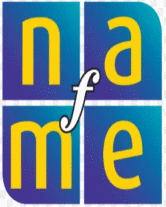Standard 1d
Singing, alone and with others, a varied repertoire of music: Students sing music written in two and three parts.
For students to sing in two- and three-part harmony they need to become comfortablewith the concept of singing harmonically, as opposed to melodically. At the beginningof each class, the teacher breaks the class into three equal parts: I (high treble), II (lowtreble), III (changing boys, alto or baritone as appropriate for their vocal development).As a vocal exercise, each section is given a note of a major triad (e.g., Part I sings e'. Part II sings c'. Part III sings g), and they sing the chord on syllables such as "mah, meh,mee, moh, moo." They repeat the process several times, each time a half step higher.
When students are comfortable with this procedure, the teacher asks them to sing a I-IV-V-l harmonic progression on the same syllables (e.g., Part I sings e', f', d', e'; Part II sings c',c', b, c'; Part III sings g, a, g, g). They sing all five syllables on each note, go on to the next chord, and repeat the pattern. This develops the aural skill of singing a part of a chord, as well as the ability to tune to the other parts. In addition, it helps to develop the independence necessary to sustain the inner voices.
The teacher then selects music that has relatively long note durations and relatively slowharmonic motion (e.g., Strommen's arrangement of "Danny Boy," Eilers's "You MustFly," or Brückner's "0 How Blessed" [Locus Iste]) until the students demonstrate theability to maintain their correct parts.
Once the students demonstrate competence at this level, the teacher introduces pieceswith more independence of voices. Many three-part treble settings of English madrigals(e.g., Wilbye's "Weep, 0 Mine Eyes") are especially helpful at this stage.
The instructional activity is successful when:
- The students perform a chord progression in tune and with good balance
- The students demonstrate the ability to sustain their individual parts in the ensemble
- The students perform music in two or three parts successfully
Excerpted from Teaching Examples: Ideas for Music Educators.

| Provided in partnership with NAfME |




